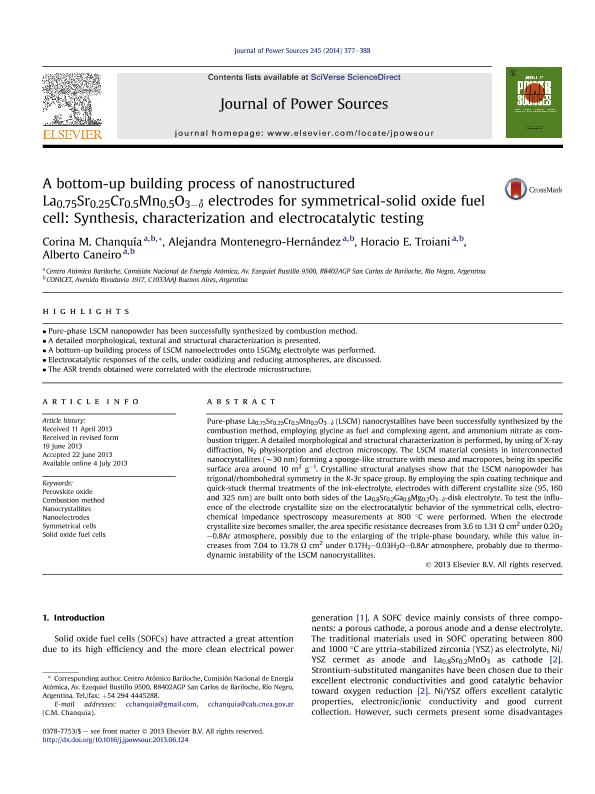Artículo
A bottom-up building process of nanostructured La0.75Sr0.25Cr0.5Mn0.5O3d electrodes for symmetrical-solid oxide fuel cell: Synthesis, characterization and electrocatalytic testing
Chanquia, Corina Mercedes ; Montenegro Hernandez, Alejandra
; Montenegro Hernandez, Alejandra ; Troiani, Horacio Esteban
; Troiani, Horacio Esteban ; Caneiro, Alberto
; Caneiro, Alberto
 ; Montenegro Hernandez, Alejandra
; Montenegro Hernandez, Alejandra ; Troiani, Horacio Esteban
; Troiani, Horacio Esteban ; Caneiro, Alberto
; Caneiro, Alberto
Fecha de publicación:
01/01/2014
Editorial:
Elsevier Science
Revista:
Journal of Power Sources
ISSN:
0378-7753
Idioma:
Inglés
Tipo de recurso:
Artículo publicado
Clasificación temática:
Resumen
Pure-phase La0.75Sr0.25Cr0.5Mn0.5O3-δ (LSCM) nanocrystallites have been successfully synthesized by the combustion method, employing glycine as fuel and complexing agent, and ammonium nitrate as combustion trigger. A detailed morphological and structural characterization is performed, by using of X-ray diffraction, N2 physisorption and electron microscopy. The LSCM material consists in interconnected nanocrystallites (∼30 nm) forming a sponge-like structure with meso and macropores, being its specific surface area around 10 m2 g-1. Crystalline structural analyses show that the LSCM nanopowder has trigonal/rhombohedral symmetry in the R-3c space group. By employing the spin coating technique and quick-stuck thermal treatments of the ink-electrolyte, electrodes with different crystallite size (95, 160 and 325 nm) are built onto both sides of the La0.8Sr0.2Ga0.8Mg0.2O3-δ-disk electrolyte. To test the influence of the electrode crystallite size on the electrocatalytic behavior of the symmetrical cells, electrochemical impedance spectroscopy measurements at 800 ºC were performed. When the electrode crystallite size becomes smaller, the area specific resistance decreases from 3.6 to 1.31 Ω cm2 under 0.2O2-0.8Ar atmosphere, possibly due to the enlarging of the triple phase boundary, while this value increases from 7.04 to 13.78 Ω cm2 under 0.17H2-0.03H2O-0.8Ar atmosphere, probably due to thermodynamic instability of the LSCM nanocrystallites.
Archivos asociados
Licencia
Identificadores
Colecciones
Articulos(CCT - PATAGONIA NORTE)
Articulos de CTRO.CIENTIFICO TECNOL.CONICET - PATAGONIA NORTE
Articulos de CTRO.CIENTIFICO TECNOL.CONICET - PATAGONIA NORTE
Citación
Chanquia, Corina Mercedes; Montenegro Hernandez, Alejandra; Troiani, Horacio Esteban; Caneiro, Alberto; A bottom-up building process of nanostructured La0.75Sr0.25Cr0.5Mn0.5O3d electrodes for symmetrical-solid oxide fuel cell: Synthesis, characterization and electrocatalytic testing; Elsevier Science; Journal of Power Sources; 245; 1-1-2014; 377-388
Compartir
Altmétricas



